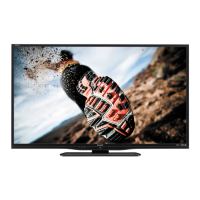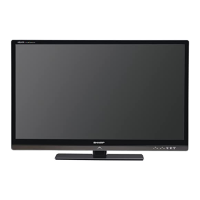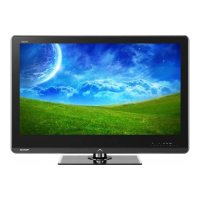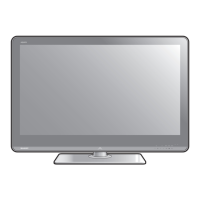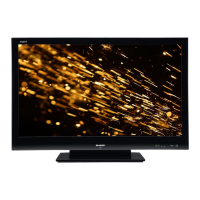Do you have a question about the Sharp Aquos LC-40LE530X and is the answer not in the manual?
Guide on how to properly connect an external antenna to the TV for optimal reception.
Instructions for connecting VCRs, game consoles, camcorders, and DVD players using composite or HDMI cables.
Details on connecting a computer and utilizing the digital audio output for external sound devices.
Identifies and describes the various buttons, ports, and indicators on the front and rear of the TV.
Information on using the headphone jack and its effect on TV audio output.
Instructions for turning the TV on, off, and entering standby mode for power saving.
Configuration options for digital channels, including auto and manual search and adjustments.
Steps for automatically or manually searching for available digital TV channels.
Fine-tuning settings for individual digital services like locking or skipping channels.
Procedure for automatically scanning for analogue channels and setting up preferences.
Manual tuning and configuration of analogue channels, including fine-tuning and system settings.
How to reorder or remove analogue channels from the channel list.
Details on specific analogue settings such as colour, sound systems, booster, skip, and lock.
Detailed controls for backlight, contrast, brightness, colour, tint, and sharpness for image quality.
Settings for colour temperature, quick shoot, and film mode to enhance picture detail and clarity.
Controls for treble, bass, balance, and SRS TruSurround HD™ for personalized sound.
Enabling and configuring SRS TruSurround HD™ and bass enhancement for immersive audio.
Settings for no signal power off, power management, and no operation power off to conserve energy.
Setting up a password to restrict access to certain TV functions and manage child lock settings.
Restricting TV channels based on age appropriateness to prevent viewing of unsuitable content.
Managing input labels, skipping inputs, and HDMI auto view settings for connected devices.
Automatic screen format switching based on WSS broadcast signals.
Choosing the correct audio input source for PC or HDMI connections.
Configuring how audio output volume is controlled, either fixed or variable.
Enhancing audio experience with automatic volume equalization and speech clarity.
Selecting digital audio output formats and managing game play time for media.
Steps for automatically or manually adjusting PC image settings for optimal display on the TV screen.
Registering specific input signal resolutions for proper PC display.
Using the auto sync feature to optimize PC image display based on signal detection.
Using manual controls for H-Position, V-Position, Clock, and Phase for PC image tuning.
Configuring preferred audio and subtitle languages, including options for hearing impaired.
Setting the local time zone and enabling over-the-air data updates for software.
How to display and navigate the Electronic Programme Guide to view TV schedules.
Scheduling reminders for upcoming TV programs that automatically tune the channel.
Guide for first-time TV use, including auto installation for analogue channels.
Selecting audio modes for NICAM broadcasts, including stereo, bilingual, and monaural options.
Managing audio modes for A2 TV broadcasts, covering stereo, bilingual, and monaural signals.
Detailed steps for using the EPG to view schedules, search programs, and set reminders.
Viewing and cancelling scheduled program reminders within the EPG.
Freezing a still image and selecting various wide screen modes for optimal viewing.
Instructions for turning Teletext on/off and using remote buttons for page navigation and information.
Details on PC-to-TV communication settings, command formats, and response codes for control.
Table showing supported PC resolutions and connection types for analogue and digital inputs.
Reference for specific commands and parameters used to control the TV via RS-232C.
Steps for connecting a USB device and choosing between photo, music, or movie playback modes.
Instructions for playing videos, navigating folders, and using full-screen playback controls.
How to play music files, navigate folders, and use playback controls for music mode.
Steps for viewing photos in full screen, rotating, and using thumbnail operations in photo mode.
Procedure for confirming DivX registration code and managing DivX VOD services.
List of compatible file extensions, containers, and codecs for photos, music, and videos.
Guidance on diagnosing and resolving common problems like no power, picture, or sound issues.
Comprehensive list of technical specifications, including panel, resolution, power, and physical dimensions.
Information on available optional accessories like wall mount brackets and their model numbers.
Instructions for securing the TV to a wall or table to prevent accidental tipping or overturning.
Instructions for securing the TV to a wall or table to prevent accidental tipping or overturning.
Steps to prepare the TV for wall mounting by removing the stand and covers.
Steps to prepare the TV for wall mounting by removing the stand and covers.
Guidance on securely mounting the TV to a wall and setting the desired viewing angle.
Detailed diagrams showing the physical dimensions and mounting points for specific TV models.
Detailed diagrams showing the physical dimensions and mounting points for the 60-inch TV model.
Details of the manufacturer's warranty terms, coverage, and conditions for consumer electronics.
Instructions regarding the sales documentation and warranty claim validation.
Guide on how to properly connect an external antenna to the TV for optimal reception.
Instructions for connecting VCRs, game consoles, camcorders, and DVD players using composite or HDMI cables.
Details on connecting a computer and utilizing the digital audio output for external sound devices.
Identifies and describes the various buttons, ports, and indicators on the front and rear of the TV.
Information on using the headphone jack and its effect on TV audio output.
Instructions for turning the TV on, off, and entering standby mode for power saving.
Configuration options for digital channels, including auto and manual search and adjustments.
Steps for automatically or manually searching for available digital TV channels.
Fine-tuning settings for individual digital services like locking or skipping channels.
Procedure for automatically scanning for analogue channels and setting up preferences.
Manual tuning and configuration of analogue channels, including fine-tuning and system settings.
How to reorder or remove analogue channels from the channel list.
Details on specific analogue settings such as colour, sound systems, booster, skip, and lock.
Detailed controls for backlight, contrast, brightness, colour, tint, and sharpness for image quality.
Settings for colour temperature, quick shoot, and film mode to enhance picture detail and clarity.
Controls for treble, bass, balance, and SRS TruSurround HD™ for personalized sound.
Enabling and configuring SRS TruSurround HD™ and bass enhancement for immersive audio.
Settings for no signal power off, power management, and no operation power off to conserve energy.
Setting up a password to restrict access to certain TV functions and manage child lock settings.
Restricting TV channels based on age appropriateness to prevent viewing of unsuitable content.
Managing input labels, skipping inputs, and HDMI auto view settings for connected devices.
Automatic screen format switching based on WSS broadcast signals.
Choosing the correct audio input source for PC or HDMI connections.
Configuring how audio output volume is controlled, either fixed or variable.
Enhancing audio experience with automatic volume equalization and speech clarity.
Selecting digital audio output formats and managing game play time for media.
Steps for automatically or manually adjusting PC image settings for optimal display on the TV screen.
Registering specific input signal resolutions for proper PC display.
Using the auto sync feature to optimize PC image display based on signal detection.
Using manual controls for H-Position, V-Position, Clock, and Phase for PC image tuning.
Configuring preferred audio and subtitle languages, including options for hearing impaired.
Setting the local time zone and enabling over-the-air data updates for software.
How to display and navigate the Electronic Programme Guide to view TV schedules.
Scheduling reminders for upcoming TV programs that automatically tune the channel.
Guide for first-time TV use, including auto installation for analogue channels.
Selecting audio modes for NICAM broadcasts, including stereo, bilingual, and monaural options.
Managing audio modes for A2 TV broadcasts, covering stereo, bilingual, and monaural signals.
Detailed steps for using the EPG to view schedules, search programs, and set reminders.
Viewing and cancelling scheduled program reminders within the EPG.
Freezing a still image and selecting various wide screen modes for optimal viewing.
Instructions for turning Teletext on/off and using remote buttons for page navigation and information.
Details on PC-to-TV communication settings, command formats, and response codes for control.
Table showing supported PC resolutions and connection types for analogue and digital inputs.
Reference for specific commands and parameters used to control the TV via RS-232C.
Steps for connecting a USB device and choosing between photo, music, or movie playback modes.
Instructions for playing videos, navigating folders, and using full-screen playback controls.
How to play music files, navigate folders, and use playback controls for music mode.
Steps for viewing photos in full screen, rotating, and using thumbnail operations in photo mode.
Procedure for confirming DivX registration code and managing DivX VOD services.
List of compatible file extensions, containers, and codecs for photos, music, and videos.
Guidance on diagnosing and resolving common problems like no power, picture, or sound issues.
Comprehensive list of technical specifications, including panel, resolution, power, and physical dimensions.
Information on available optional accessories like wall mount brackets and their model numbers.
Instructions for securing the TV to a wall or table to prevent accidental tipping or overturning.
Instructions for securing the TV to a wall or table to prevent accidental tipping or overturning.
Steps to prepare the TV for wall mounting by removing the stand and covers.
Steps to prepare the TV for wall mounting by removing the stand and covers.
Guidance on securely mounting the TV to a wall and setting the desired viewing angle.
Detailed diagrams showing the physical dimensions and mounting points for specific TV models.
Detailed diagrams showing the physical dimensions and mounting points for the 60-inch TV model.
Details of the manufacturer's warranty terms, coverage, and conditions for consumer electronics.
Instructions regarding the sales documentation and warranty claim validation.
| Screen Size | 40 inches |
|---|---|
| Resolution | 1920 x 1080 pixels |
| Display Type | LCD |
| Backlight Type | LED |
| HDMI Ports | 3 |
| USB Ports | 1 |
| Refresh Rate | 60 Hz |
| Aspect Ratio | 16:9 |
| Built-in Wi-Fi | No |
| Smart TV | No |
